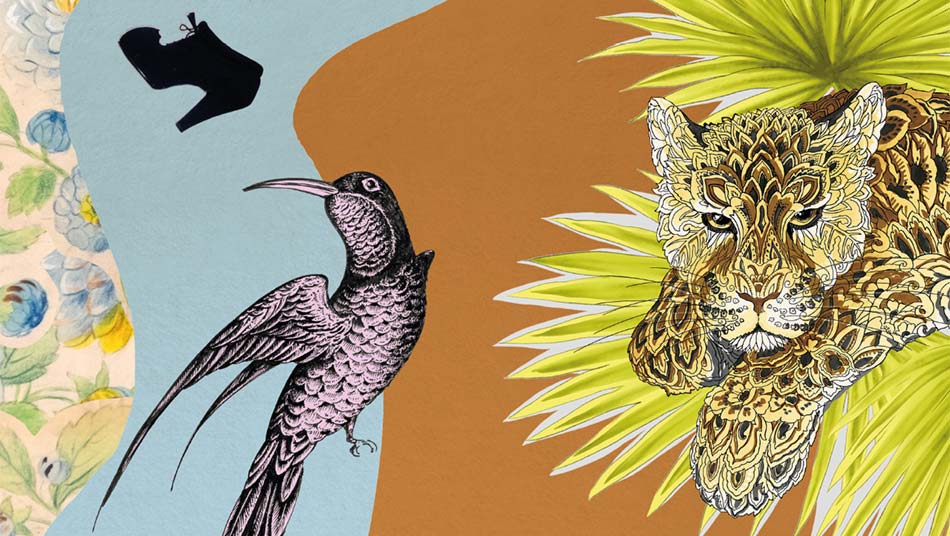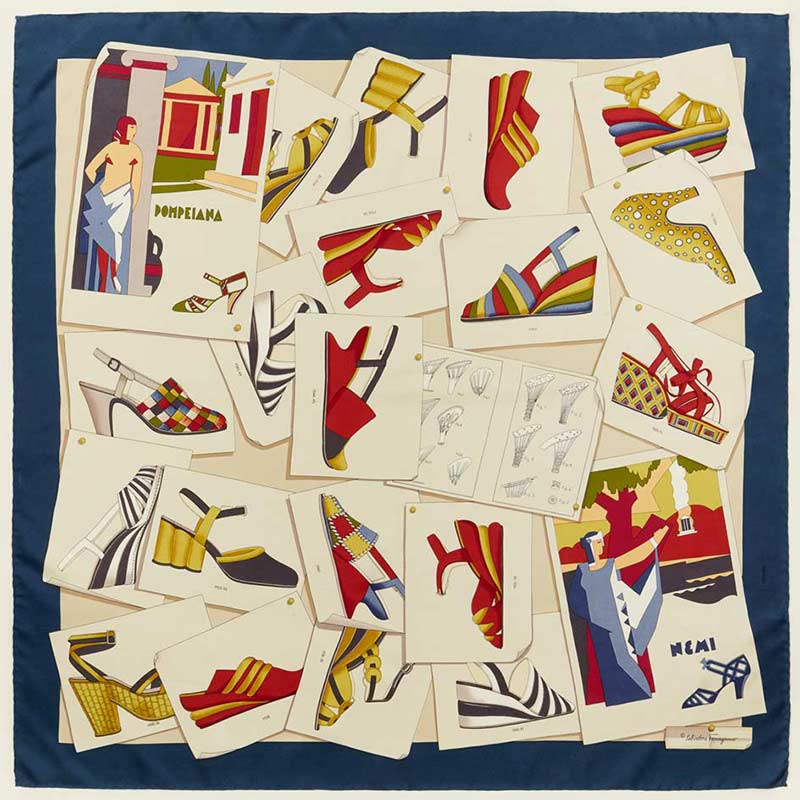
SILK at Museo Salvatore Ferragamo. A Wunderkammer celebrating Fulvia Ferragamo’s legacy.
05 Maggio 2021
It was the desire of the Ferragamo family that the Museo Salvatore Ferragamo (opened in 1995) would celebrate not just the creativity of its founder Salvatore. It would make known to the public, particularly the younger generations, the artistic qualities of the fashion house, the limitless imagination and inventions, which changed the role of footwear in international fashion and elected Salvatore Ferragamo as one of the great protagonists of 20th century design.
Like most corporate museums, Museo Salvatore Ferragamo and its archives stem from the vision of an entrepreneur. In this case it was Salvatore Ferragamo’s widow, Wanda, who headed the company since the founder’s death in 1960, and her six children. In particular, the eldest of their children, Fiamma, who managed the company’s core footwear and leather goods business after her father’s death, stood at this project’s helm on behalf of her family and brought it to life, shaping its strategy with the assistance of historians and archivists.

Museo Salvatore Ferragamo, Florence.
From 2006, in order to make the life of the museum as dynamic as the life of the company, it was decided to modify its exhibition structure and to select every year a different research theme that, starting from the experience of Salvatore Ferragamo, the history of his life, his creations, the customers he served and his values, gives the opportunity to discover the world of Ferragamo in an indirect way combined with other cultural expressions such as Art, Architecture, Design, economic and social History and Philosophy. Each time the museum looks different, with different set-up and different contents.
It’s precisely the case with the museum’s latest exhibition “SILK”, which aims to reveal the long and complex process that leads to the creation of a printed silk scarf, the perfect union of extraordinary creative intuition and high-level industrial craftsmanship, taking as its example the Maison Salvatore Ferragamo, an Italian fashion company that has made this accessory, together with the tie, one of the most widely-acknowledged vectors of its style.
The exhibition is curated by ITS Jury member Stefania Ricci, Director of Museo Salvatore Ferragamo and Fondazione Ferragamo. We had the great pleasure of chatting with her about it, to dive deeper into the complexities and fascinations of organizing an exhibition of this kind.

Salvatore Ferragamo, Ninfea, Fall/Winter collection 1995–96, silk twill scarf. 
Preparatory drawings and collages for Salvatore Ferragamo scarves, 1970–2000, pencil and collage on paper. 
Salvatore Ferragamo, Poster, Spring/Summer collection 1991, silk twill scarf.
ITS: The curatorial approach you have chosen is extremely interesting: for each of the scarves on display you have included the sources of inspiration – books, paintings, vases, sculptures, preparatory drawings – and the exhibition tells of the great conceptual and productive complexity behind what look like simple silk prints to the neofite. Collecting all of this material and coordinating so many different institutions to be able to set up everything in the exhibition must have been equally fascinating and challenging: are there any particular or amusing anecdotes related to this process that you can share with us?
SR: The work was very complex, because the curatorial idea stemmed from the collages made by the designers of the Ferragamo silk department under supervision of Fulvia Ferragamo Visconti, which were used as a moodboard for the designs of the collections. But the collages did not contain any written references to the sources from which the images had been drawn. It was therefore a question of organizing a real treasure hunt, a kind of guessing contest involving our entire office, not just the curators. In the end we were so obsessed with flowers and animals, that we kept sending us photos of specimens via whatsapp, even during our free time and our holidays.
ITS: You have worked on an immense amount of material, produced during the development of each creation: your historical archive contains over a thousand volumes that bring together mood boards, trials, sketches, drawings… creative elements not necessarily used in the final product. Needless to ask how difficult it was to make a selection. What we’d like to know instead is: Were there any forced renunciations you wished you could have included in the exhibitions?
SR: There were so many. First of all we chose those subjects that represent the identity of the brand: the animals of the jungle and the savannah, the birds, the exotic themes, the historical shoes of the museum, the flowers, to reinforce the concept of the exhibition. We also had to limit ourselves due to the amount of available space, since the scarves have a considerable size, 90×90 cm. Whenever we excluded one scarf, we reintroduced two. It was impossible to part with such beautiful accessories. Each scarf is like a painting.
ITS: In every exhibition the Ferragamo Museum gives space to young creativity, called to interpret the theme of the exhibition. Could you briefly tell us about the installation project developed with 5 students coordinated by their teachers?
SR: The project with the artistic high school in Porta Romana, Florence, started two years ago. Five young students were selected among many to create designs for the window panels that would accompany the launch of the four fragrances of the new perfume “Storie di seta”, fragrances inspired by the worlds of Ferragamo silk: “Silk gardens”, “Silk oceans”, “Silk jungles” “Silk savannahs”. The students were presented with the exhibition project, its contents and the fragrances. They understood the message behind each fragrance and got to know the olfactory components. Then they started working. The situation turned complicated due to the Covid-19 emergency. They worked in isolation, without the help of their teachers, coping with the materials they had available. In the meantime, the show was postponed for a year and at that point the showcase project coincided with the show, which already had special showcases planned. The work of the students, however, was so valuable that I thought it important not to abandon it, giving it the space it deserved in the exhibition. Creativity must always be rewarded, especially when it is expressed by young people who need to be encouraged and supported.

ITS: Fulvia Ferragamo – who was the founding, driving and creative soul of the company’s silk production – is obviously felt in every corner of the exhibition. The installation itself, almost a Wunderkammer, seems to recall her personal interest for travel (especially China and India), during which she would collect curiosities and small antiques, fueling her creative development. In creating the exhibition, what did you consider essential to pay tribute to her?
SR: We wanted to show that behind an accessory such as a foulard and a tie, accessible to all, there is not only a lot of creativity, craftsmanship and technical excellence but also a lot of research and culture, which is the true essence of Made in Italy and the reason it is so appreciated. Above all, there is the passion for one’s work, which becomes an integral part of life and its values.

Museo della Natura Morta, Poggio a Caiano (Prato).
ITS: Let’s imagine you’re not the curator. You are one of the visitors and you’ve just seen the exhibition. What are the pieces that have fascinated you the most?
SR: So many… it is hard for me to make a choice among so many works of art, beautiful illustrations, perfect drawings. But I think that the collages are indeed the most incredible pieces, because they show how the creative process develops, how an idea can develop from scrap and turn into a masterpiece of its own.
MUSEUM OPENING HOURS
From Monday to Sunday – hours 11:00 – 19:00.
Closed on: January 1st, August 15th, December 25th.
Free entrance on the first Sunday of the month.
In order to guarantee a complete safety experience, according to current regulations, access to the museum is allowed with the obligation to wear the mask and respect of social distancing.
The entrances will be contingent and organized on entrance bands of 30 minutes each. Reservations are recommended.
VIRTUAL TOUR
For all those who have not yet been able to go to the museum in person, it will be possible to visit the exhibition through the virtual tour available here.
